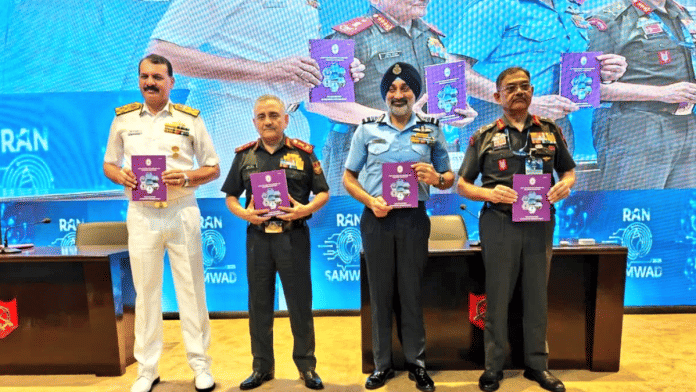New Delhi: Indian Special Forces (SF) must now prepare to operate not only in the physical domain but also in the contested arena of perception, according to the country’s first publicly available Joint Doctrine for SF operations.
Conducting offensive and defensive information campaigns, countering propaganda and shaping narratives to secure advantage is an operational imperative, it added.
Issued alongside a separate doctrine on airborne and heliborne operations, the unclassified document was unveiled Wednesday by Chief of Defence Staff (CDS) General Anil Chauhan at the ‘Ran Samwad’ tri-service seminar held at the Army War College in Mhow.
“The human mind is an emerging battlespace. Adversaries are leveraging social media, deep fakes, and psychological operations to influence public opinion and destabilise societies,” the doctrine reads. “Indian SF must be capable of conducting offensive and defensive Information Operations, countering propaganda, and exploiting the information domain for operational advantage. Enhanced skills in cultural awareness, strategic communication, and psychological resilience will be crucial.”
Formulated under the aegis of the Doctrine Directorate at Headquarters Integrated Defence Staff, with active input from all three armed services, the doctrine sets out guiding principles, operational concepts and interoperability frameworks for SF missions. It identifies the information domain as a critical battlespace, on a par with conventional military operations.
The text also stresses that SF must be ready for multi-domain operations, with hybrid warfare increasingly combining “traditional military force with disinformation, cyber intrusions, economic coercion and the use of proxy actors.”
The emphasis in the doctrine comes in the wake of Operation Sindoor, which demonstrated that narrative carries massive operational weight alongside kinetic action. In May, General Chauhan revealed that around 15 percent of effort during the operation went into countering hostile disinformation and false narratives. He added that misinformation is persistent rather than episodic, requiring measured, non-reactive responses to deny adversaries the space to shape perception.
Earlier this month, Army Chief General Upendra Dwivedi also underlined the centrality of narrative in modern conflicts.
“Victory is in the mind,” he said, pointing to how Pakistan attempted to portray Operation Sindoor as a success despite setbacks on the ground. “If you ask a Pakistani whether you lost or won, he’d say, ‘My chief has become Field Marshal, we must have won only‘.” The episode, he argued, illustrates that perception management is no longer peripheral but integral to operations, and he called for a dedicated “narrative management system” to consolidate this capability.
Meanwhile, the document also signals a potential expansion of the Armed Forces Special Operations Division (AFSOD), India’s only standing tri-service special operations formation. Raised in 2018 and fully operational the following year, AFSOD, comprising roughly 3,000 SF personnel, brings together the Army’s Para SF, the Navy’s MARCOS and the Air Force’s Garud Commandos.
It says that “the organisational structure and role of AFSOD could be expanded in future in keeping with operational requirements. AFSOD will be under COSC for tasks mandated by the COSC and in support of operations in various theatres,” suggesting a potential evolution from a division-level formation to a full-fledged command reporting directly to the Chiefs of Staff Committee (COSC), bringing the country closer to the long-envisaged model of a Special Operations Command (SOC).
Additionally, the joint doctrine also outlines reforms to the training ecosystem. Currently, each service operates its own institutions. However, under the proposed changes, these would be upgraded into Joint Service Training Institutes (JSTIs), each serving as a Centre of Excellence in a specific core competency and drawing on pooled resources from all three services.
“Existing Special Forces Training Schools of three Services need to be upgraded to Joint Service Training Institutes,” it notes, while clarifying that command and control would remain with the parent service.
(Edited by Tony Rai)
Also Read: First-of-its kind tri-services conference Ran Samvad to take place in Army War College next week




